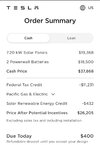I agree with you ... but PG&E, SCE, and SDG&E think differently. They just submitted a motion to bring the latest "Inflation Reduction Act" into scope for the NEM 3.0 proceeding. Basically they are challenging the CPUC to re-visit that economics model around expected payback under NEM 3.0 since consumers now get the extra ITC benefit.
Yes, the IOUs want tweaks to the NEM 3.0 economics to worsen the payback model that even
@Redhill_qik probably cannot replicate with logical assumptions. Their claim is that the savings from the new law make Solar pay back too soon, so the pay back must be worsened.
So here's where I think the California solar industry has an issue. If solar installers increase prices to basically claim the tax credit for themselves (something every company does), then PG&E will argue the solar industry is greedy and not taking an opportunity to let the federal government subsidize more installs. So the solar industry will lose on efforts to pursue changes to the existing NEM 3.0 PD.
If solar installers keep prices the same and allow the full benefit of the increased ITC to end up with the buyers, then the buyers need to give this benefit to PG&E by way of worse NEM 3.0 economics compared to what we saw in the PD.
From the Joint IOUs:
"The Inflation Reduction Act, and more specifically, the extension of the 30 percent tax credit for both non-residential and residential solar projects, is directly relevant to the modeling of a successor net energy metering tariff in this proceeding. Importantly, the modeling assumptions for the net billing tariff proposed in the December 13, 2021 Proposed Decision of Administrative Law Judge Kelly A. Hymes take into account the then-existing tax credit (and phase out), providing only the 22 percent credit previously available in 2023.3 All else equal, a 30 percent tax credit (as compared to a 22 percent credit) reduces the cost of solar adoption, thereby reducing the payback period for customers benefitting from the tax credit. The more generous tax credits under the Inflation Reduction Act, therefore, have a direct impact on the modeling of the successor to the existing net energy metering tariffs."
Just for funsies, I went and got a quote for solar only this week. 4.38 kWp DC or 3.8 kWp AC. They want $23,356 BEFORE incentives. That is $5.33 per watt. I am not making this stuff up. No ESS... no special whatever... this is just the "take it or leave it" quote.
View attachment 844384
I keep posting this chart from the NEM 3.0 PD over and over, but remember the CPUC thinks solar is only $2.59 per watt BEFORE incentives. Something doesn't seem right here if installers charge $5.33 per watt to make their at-scale economics work, while the CPUC thinks it's less than half that value.
View attachment 844383




